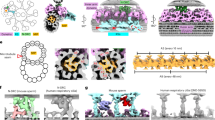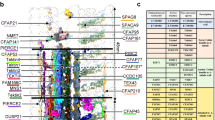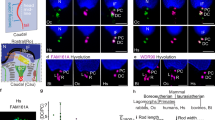Abstract
THERE is considerable evidence that movement of cilia and flagella depends on slip or sliding between tubules1–3. The evidence, however, is confined largely to cilia and flagella with the common arrangement of a central pair of microtubules surrounded by nine double tubules, the ‘9+2’ arrangement. Coccid insects have filamentous spermatozoa with motility much like flagella and yet they have an arrangement of microtubules quite different from the 9+2 type4–8. Although there is reason to believe that slip between microtubules may be involved in morphogenesis of the corkscrew-shaped region of sperm bundles of the mealybug Pseudococcus obscurus9, apparently no evidence of slip in movement of coccid sperm has been reported.
This is a preview of subscription content, access via your institution
Access options
Similar content being viewed by others
References
Satir, P., J. Cell Biol., 39, 77 (1968).
Summers, K. E., and Gibbons, I. R., Proc. natn. Acad. Sci. U.S.A., 68, 3092 (1971).
Brokaw, C. J., Science N.Y., 178, 455 (1972).
Robison, jun., W. G., thesis, Univ. California, Berkeley (1965).
Robison, jun., W. G., J. Cell Biol., 29, 251 (1966).
Ross, J., and Robison, jun., W. G., J. Cell Biol., 40, 426 (1969).
Robison, jun., W. G., in Comparative Spermatology (edit. by Baccetti, B.), 311 (Accad. Naz. Linc., Rome, and Academic Press, New York and London, 1970).
Robison, jun., W. G., J. Cell Biol., 52, 66 (1972).
Ross, J., Tissue and Cell, 3, 35 (1971).
Harris, W. F., thesis, Univ. Minnesota, Minneapolis (1970).
Harris, W. F., Nature, 240, 294 (1972).
Harris, W. F., and Scriven, L. E., J. Mechanochem. Cell Motil., 1, 33 (1971).
Read, W. T., Dislocations in Crystals (McGraw-Hill, New York, 1953).
Harris, W. F., J. Cell Biol., 46, 183 (1970).
Nabarro, F. R. N., Theory of Crystal Dislocations (Clarendon Press, Oxford, 1967).
Eshelby, J. D., Phys. Stat. Sol., 2, 1021 (1962).
Author information
Authors and Affiliations
Rights and permissions
About this article
Cite this article
HARRIS, W., ROBISON, W. Dislocations in Microtubular Bundles within Spermatozoa of the Coccid Insect Neosteingelia texana and Evidence for Slip. Nature 246, 513–515 (1973). https://doi.org/10.1038/246513a0
Received:
Revised:
Issue Date:
DOI: https://doi.org/10.1038/246513a0
This article is cited by
Comments
By submitting a comment you agree to abide by our Terms and Community Guidelines. If you find something abusive or that does not comply with our terms or guidelines please flag it as inappropriate.



